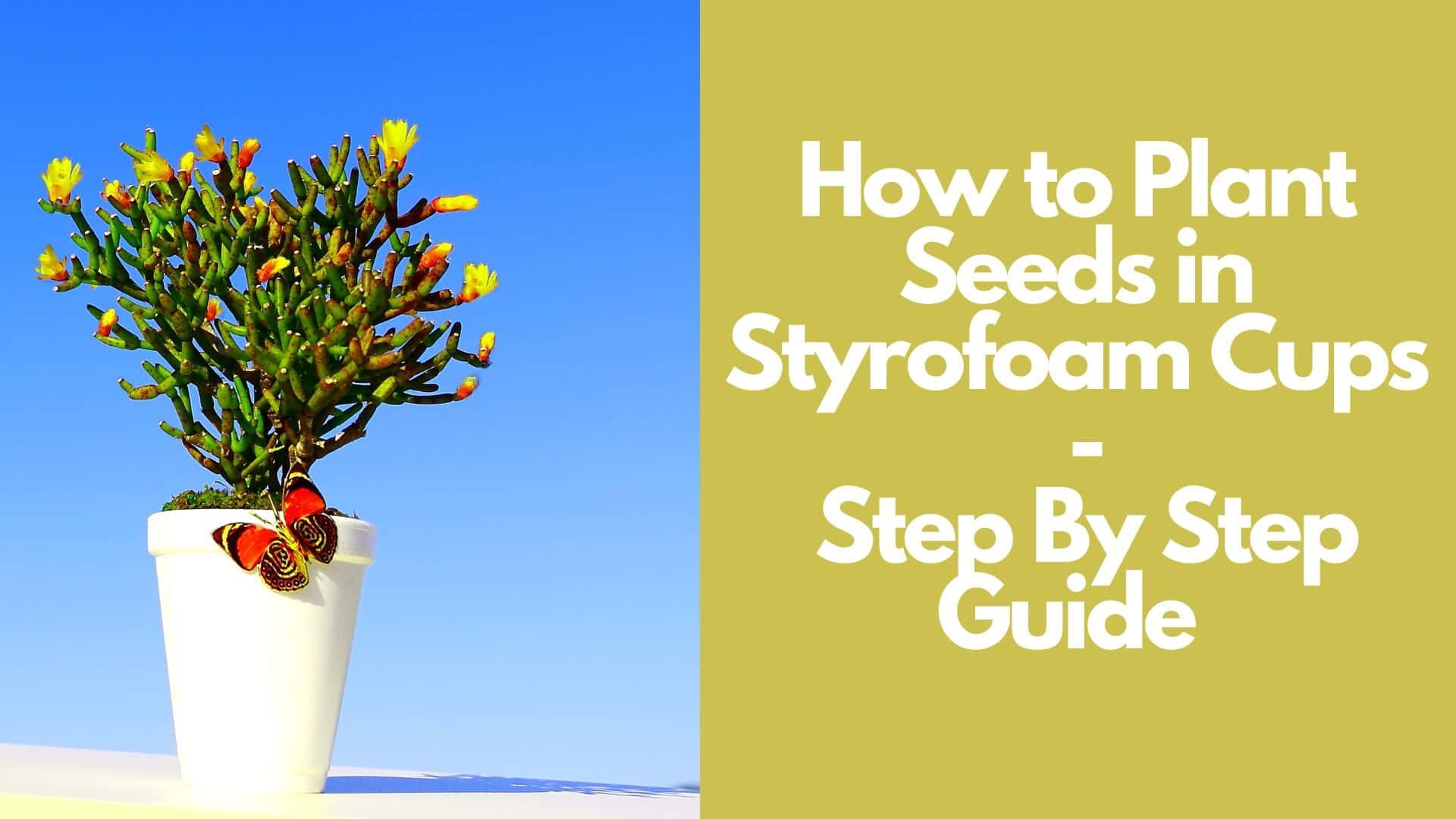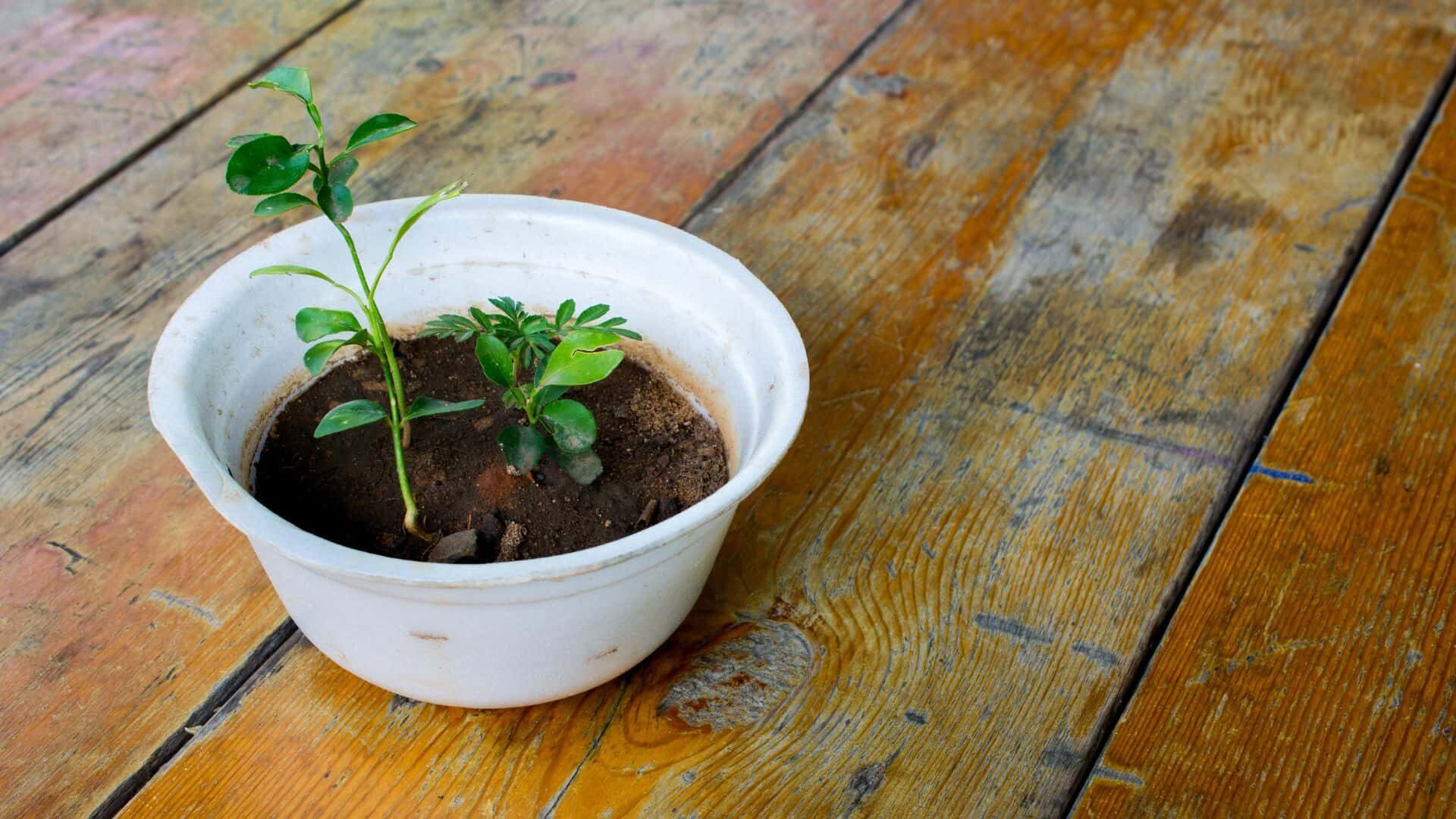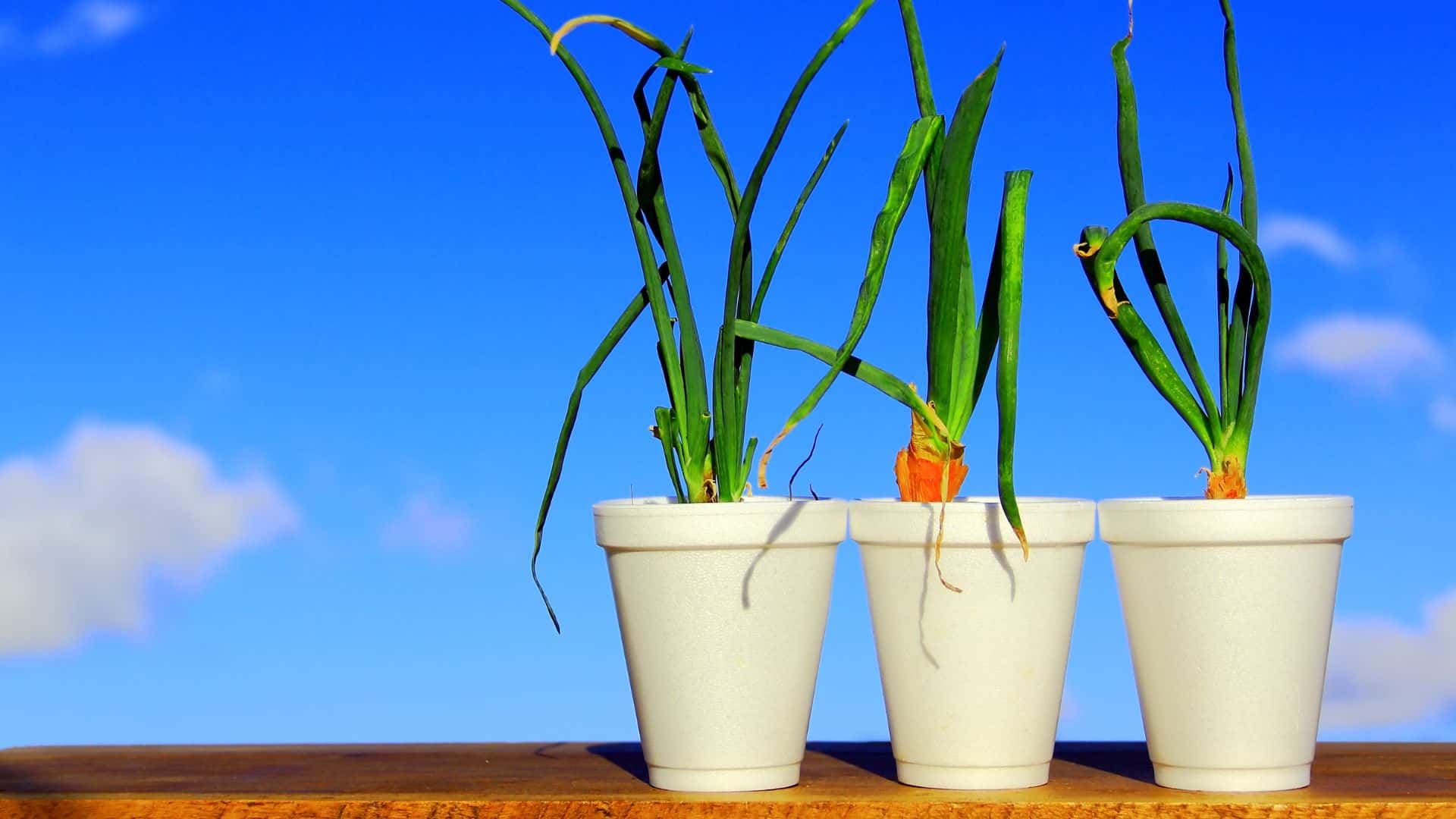Please don’t waste time and energy throwing away your used Styrofoam coffee cups; instead, put them to good use so they don’t end up in a landfill. You may reduce your expenses while helping the planet at the same time. Spruce up those Styrofoam cups by decorating them.
Many gardeners start seeds indoors in the last few weeks of winter or the first few days of spring to get a head start on the growing season. It is simple to start seeds indoors when it is too cold to plant outside and then move them to the ground when the temperature rises. What, then, can you use for seedlings other than expensive seed-starting trays? Used Styrofoam cups from events or camping excursions work great. Planting seeds in Styrofoam cups is not difficult. You can use the cups as temporary or permanent homes for your plant friends, and in the end, you’ll have the loveliest little container garden ever!
If you’re curious about this but haven’t tried it before, here is the guide. By reading this guide, How to Plant Seeds in Styrofoam Cups.

Let’s start,
What are the benefits of planting seeds in Styrofoam cups?
Planting seeds in styrofoam cups may seem strange, but it’s pretty standard. Gardeners have found this practical, and many positive outcomes can attain. The practice of starting seeds inside is widespread. In preparation for planting outside when the weather warms up, many gardeners begin the process of cultivating their plants from seed indoors.
1. Cost-effective.
A great benefit of starting seedlings in styrofoam containers is the low cost. If you’re creative, you don’t want to go out and buy expensive containers for your plants. Using a smaller pot to start your seeds can save you a lot of money on larger containers later.
Even better, a new set of styrofoam cups costs less than a single pot or planter.
2. Able to start before the growing season.
Whether you have a long or short growing season, all gardeners like taking advantage of the colder months of winter and spring to get a head start on planting seeds. While many people have greenhouses, others start plants in their own homes.
You can gain up to eight weeks of growing time by starting seeds inside cups. As a result, you could get tomatoes for up to eight weeks longer than if you had planted seeds outdoors.
3. Easy to create a pretty indoor garden.
Growing in a cup might be an excellent alternative to starting a container garden for those living in urban areas with limited outside space. Without a large backyard garden, gardeners can still benefit from growing fresh food and herbs using a sunny windowsill or artificial light. Let’s face it: all those tiny planters filled with greenery sprigs will be adorable.
4. Ability to recycle the cups.
There are a lot of positive results that can come from germinating seeds in individual cups. Recycling is a top option. There are a lot of single-use plastic cups that end up in landfills.
These can be given new life by being transformed into seed-starting cups. They’ll serve you well for many years of repeated use. The planet and its gardening community give their approval.
5. Root development can observe visually.
Many transparent cups are available, so you can see the roots develop. Seeing the roots form will calm your nerves and convince you that your seedling generally grows while you wait for it to sprout.
Without seeing the roots, gardeners are more likely to pull the plant out of the ground to investigate. The plant may fall into shock as a result of this and die. Using see-through cups allows you to monitor the progress of your seedlings and protects your plants from potential harm.
6. Easy to move.
Styrofoam cups are fantastic because they don’t weigh very much. Because they are smaller than typical cooking pots, these cups are convenient to take with you wherever you go. It is excellent if you have limited room and need to move your plants frequently.
Styrofoam cups make it easy to relocate delicate seedlings from one location to another to optimize their exposure to light.
How to plant seeds in Styrofoam cups?
Seed-starting is a great way to get an early start on the growing season, and if you have any styrofoam cups, you can use them to build a simple and inexpensive garden.
What materials do you need to plant seeds in the Styrofoam cups?
- Styrofoam cups
- Seeds
- Potting Soil Mix
- Dish wash/Soap
- Water
- Permanent Marker
- Sharp Pencil
- Plastic cover
What are the steps of planting seeds in Styrofoam cups?
There are a few steps that you should follow when planting seeds in Styrofoam cups. Keep reading.
1. Determine the number of cups required.
To begin, count how many styrofoam cups will require. How many you can grow in a given space is determined by the size of your plant containers and the number of plants you intend to cultivate. More may be required if using smaller cups rather than larger ones.
One rule of thumb is to limit each plant to a single cup. It will prevent your plants from being overcrowded as they expand.
2. Get the Styrofoam cups ready to use as plant containers.
Wash a Styrofoam cup with dish soap and hot water to remove any food particles. If you’ve used the cup for starting seeds before, give it a five-minute soak in a solution of one part bleach to nine parts water to kill bacteria.
Cups can be decorated with paints or markers and set aside to dry after use. Always leave a little white space to identify which cups belong to which people.
How to put the hole in the bottom of the Styrofoam cups?
You should turn the Styrofoam cup and use a sharp pencil to make four holes in the base of the cup. Make sure the holes are dispersed uniformly around the base. Make them approximately a quarter of an inch in diameter to allow water to drain but prevent soil from washing through.
3. Fill the cups with soil.
Add fertile seed-starting mix or peat moss with potting soil to the Styrofoam cup until it is about 3/4 inch from the top. Firm up the medium in the cup by tamping it down. Apply water in a slow, steady stream until the soil is equally saturated but not soaked.
If you want to start seeds indoors, don’t use garden soil because it’s often too heavy and compacted.
4. Sow seeds on the soil.
Put two or three seeds on the soil’s surface, leaving at least an inch between each one. Plant the seeds at the depth specified on the seed packet. Typically, seeds are planted at a depth of a quarter to a half an inch, while tiny seeds sometimes scatter throughout the soil’s surface.
If there are no other guidelines, you should use a depth of seed-starting mix equal to two times the seeds’ diameter to bury them. After sowing, press the soil firmly over the seeds.
5. Water seeds properly.
Use a spray bottle filled with water to wet the top soil layer. Put the Styrofoam cup in a plastic bag, or wrap some plastic around it and fasten it with an elastic band to keep the dirt inside from drying up. A glass cover can place over the cup instead.
6. Keep the planted cups in a warm place.
It would help to find a suitable environment for your seeds once you’ve planted them. Get your mugs out of the direct sunshine and put them somewhere toasty and bright. It would be an ideal spot for a greenhouse or sunroom.
You can achieve the same results from placing your cups on a sunny windowsill as you would from a greenhouse or sunroom.
If the temperature isn’t staying high enough in your cups, you can try placing them on a heat mat. Be careful that the carpet doesn’t grow too hot, as that could cause burns to your plants.
7. Keep a close eye on your seeds.
When the time comes to wet the soil for the germination process, take off the plastic or glass cover from the Styrofoam cup. After doing, put the top back on. Be sure your seeds are getting enough water by keeping an eye on them. In other words, the soil has to be damp but not soaked. Lightly sprinkle the ground with a spray bottle or watering can if it dries out.
When the seeds germinate, remove the cover from the Styrofoam cup and set it on a south-facing window where the temperature stays between 60 and 70 degrees Fahrenheit. Alternately, you might leave the seedlings under a fluorescent light for 16 hours daily. The light should never be closer than six inches to the top of the pots to maximize plant growth.
Using scissors, snip the roots of the weaker seedlings at the soil level until just one healthy seedling is left in the Styrofoam cup.
8. Transplant the seedlings.
The seedlings should transplant after they have reached the appropriate size. Check the seed packets for specifics, but most plants are generally suitable for transplanting when they have two sets of leaves and are approximately 3 to 5 inches tall.
What plants do well in Styrofoam cups?

Even though most plants can have their early stages of development in a cup, not all will mature into robust, tasty adults. While most herbs can thrive in Styrofoam cups, fruiting and veggie plants will likely need to be moved to a larger container or planted in the ground.
It doesn’t take a gardening expert to cultivate herbs successfully in a cup. Styrofoam cups don’t need a lot of room, and wide varieties will continue to expand in a single cup even after you’ve harvested them. Below are some plants that grow well in cups.
1. Strawberries
Growing strawberries is a breeze, and the resulting sweet, juicy berries are practically irresistible. If you plant enough seeds of different kinds, you can harvest from early summer through fall. Since they don’t need much room, they thrive in Styrofoam cups and vertical gardens.
2. Lettuce
If you want to eat fresh, gourmet salad greens without breaking the bank, lettuce is the plant for you. Lettuce thrives in the chilly, damp conditions of the spring and fall seasons since it is a cool-season crop.
3. Basil
Many people consider basil an essential herb worldwide. It’s safe to say that basil plants are among private gardens’ most widely cultivated culinary herbs.
If you follow these straightforward procedures, you’ll have beautiful basil plants in no time, whether growing them in the ground or in Styrofoam cups.
4. Peppers
The pepper is one of the most profitable plants to cultivate in a garden for human use. Very fruitful, providing gardeners with more fruit than they can eat and aesthetically pleasing as the fruit matures.
5. Rosemary
Salvia Rosmarinus, often known as rosemary, is a perennial evergreen shrub that produces a fragrant herb of the same name. It grows tall with straight woody stems and narrow, needle-like leaves that are grayish green. It usually blooms in the late spring or early summer, but it can flower at other times of the year.
It produces clusters of small, light blue to white flowers. Rosemary should be planted in the spring once all danger of frost has passed. Rosemary can also be grown in the house. However, it will eventually become huge. The growth and spread of this shrub are moderate.
6. Parsley
The summer harvest of parsley, a simple annual to grow, is plentiful and flavorful. Flat-leaf cultivars have a more excellent flavor and are typically easier to prepare in the kitchen, whereas curly-leaf species are more ornamental but less tasty.
The leaves are chopped and used in various ways, including as a garnish or for sauces, butter, and dressings.
Watch how to transplant tomato seedlings in Styrofoam cups | Video
Top 5 FAQs & answers related to How to Plant Seeds in Styrofoam Cups: Smart Tips & Tricks
Is Styrofoam waterproof?
Its low weight is due to the high percentage of air within Styrofoam. It can withstand some moisture but won’t stay dry in the long run; in many situations, it will soak in water.
Is it possible to grow roses in styrofoam cups?
Take cuttings of the growing tips of your rose bushes in the winter and root them in soil that drains properly in your garden or tiny pots indoors.
Each Styrofoam cup should have a hole punched in the bottom with a pencil for drainage if you plan on using them as propagation pots. Keep an eye on the soil moisture levels every day.
Can I use Styrofoam cups to plant seedlings?
How foam cups react with your plants is a function of their intended use. Foam cups are perfect for use as seed starting containers. In addition, they prevent outdoor seedlings from freezing during late-season cold outbreaks. However, outdoor seedlings in foam cups can quickly perish if left covered.
Is it good to use Styrofoam cups for plants?
Adding Styrofoam packing peanuts could cause more problems than it solves if you’re using a pot with poor drainage. Plants with deep roots may become saturated and rot or die if the foam doesn’t have enough drainage.
Can I plant tomato seeds in Styrofoam cups?
If you want to maximize your tomato harvest, planting seeds indoors earlier in the year is the way to go. Tomato seedlings thrive in Styrofoam coffee cups because they are cheap, lightweight, and roomy enough for a healthy root ball to grow.
Conclusion
By reading this guide, I hope you got the full idea of How to Plant Seeds in Styrofoam Cups: Smart Tips & Tricks.
Please share this How to Plant Seeds in Styrofoam Cups: Smart Tips & Tricks with your friends and do a comment below about your feedback.
We will meet you on next article.
Until you can read, How to Get Rid of Black Spots on Aloe Plant: 10 Solutions
